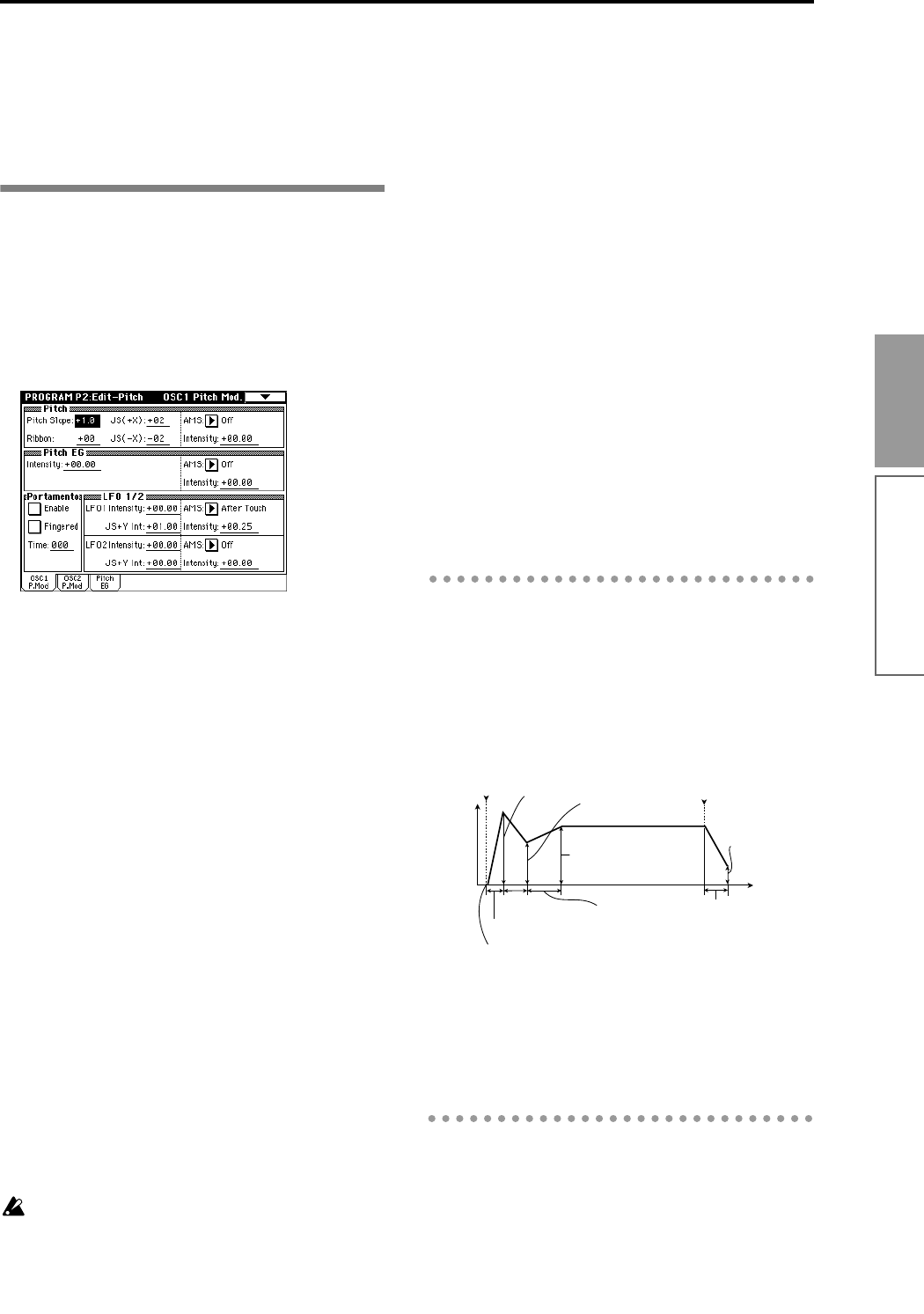
47
Basic functions
Controller Setup tab
For each program, this tab lets you make settings for
the [SW1] and [SW2] keys, and for the B-mode of
REALTIME CONTROLS knobs [1]–[4] (
☞p.127). (☞p.8,
217, 218 in the Parameter Guide)
P2: Edit-Pitch Pitch settings
Here you can specify how the pitch of the multisample
selected for the oscillator will change. Pitch EG and
LFO settings allow the pitch to varied over time. When
the “OSC Mode” is Single or Drums, only the OSC1
P.Mod. tab is available.
OSC1 Pitch Mod. tab
Pitch
JS(+X) and JS(-X) specify the amount of pitch change
that will occur when the joystick is moved to right or
left, in semitone units. With a setting of +12 the pitch
can be raised a maximum of one octave, and with a set-
ting of –12 the pitch can be lowered a maximum of one
octave.
“Pitch Ribbon” specifies the amount of pitch change
that will occur when you operate the ribbon controller
toward the left or right. With a setting of +12, moving
your finger to the right edge will raise the pitch one
octave, and moving your finger to the left edge will
lower the pitch one octave.
Pitch EG
When the “Intensity” value is set to +12.00, the pitch
EG specified in the Pitch EG tab will produce a maxi-
mum of ±1 octave of pitch change.
Portamento
If “Enable” is checked, portamento will be applied.
Portamento makes the pitch change smoothly when
you play the next note before releasing the previous
note.
The “Time” parameter specifies the portamento time.
As this value is increased, the pitch will change over a
longer time. With a value of 000, there will be no porta-
mento.
If Porta.SW CC#65 is assigned as the function of
[SW1] or [SW2] key, the portamento effect can be
switched on/off by [SW1] or [SW2] key.
LFO 1/2
An LFO can be used to cyclically modulate the pitch
(the “vibrato” effect).
“LFO Intensity” specifies the amount of pitch change
that the LFO will produce. With a setting of +12.00,
vibrato will produce a maximum of ±1 octave of pitch
change.
“JS+Y Int” specifies the amount of vibrato that the LFO
will produce when the joystick is pushed away from
yourself.
“AMS Intensity” specifies the amount of vibrato that
the LFO will produce when an AMS (alternate modu-
lation source) is operated. For example if “AMS” is set
to After Touch, vibrato will be applied when you
apply pressure to the keyboard.
Pitch EG tab
Here you can make settings for the pitch EG.
When you wish to create sound effects etc., set the
pitch EG to make major changes in pitch over time.
To realistically simulate the slight change in pitch that
occurs when a string is plucked or at the attack of a
brass or vocal sound, you can use the pitch EG to cre-
ate a subtle change in pitch at the attack (
☞p.10 in the
Parameter Guide).
EG and LFO
When controlling the pitch, filter, and amplifier, the EG
(envelope generator) and LFO (low frequency oscilla-
tor) are used to create time-varying and cyclical
changes.
EG (Envelope Generator)
The TRITON provides a Pitch EG, Filter EG, and
Amplifier EG, which produce time-varying changes in
pitch, tone, and volume respectively.
LFO (Low Frequency Oscillator)
For each oscillator, the TRITON provides two LFO’s
that can be used to apply cyclical change in pitch, tone,
and volume.
Examples of this are “vibrato” (cyclical change in
pitch), “wah” (cyclical change in tone), and “tremolo”
or “auto-pan” (cyclical change in volume).
Level
Time
Attack Time
Decay Time
Slope Time
Release Time
Attack Level
Start Level
Sustain Level
Break Level
note-on
note-off
Release Level
Program mode


















